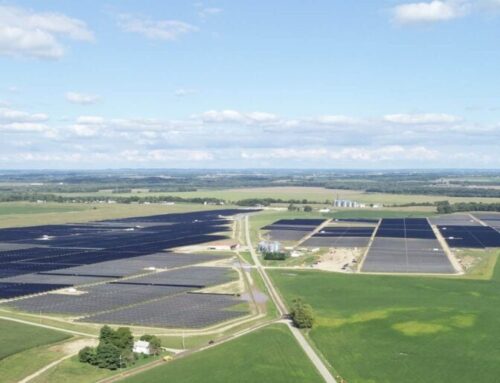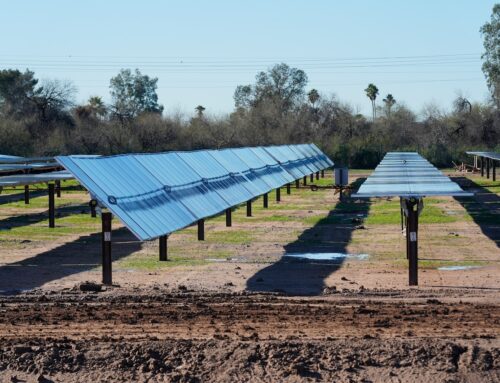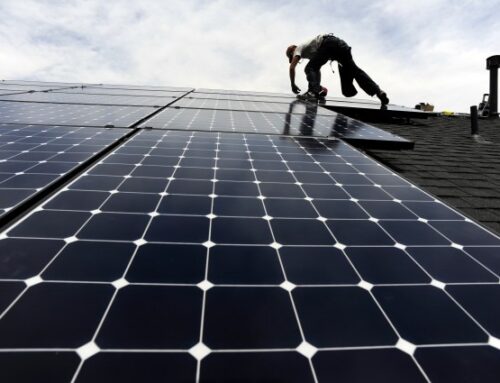Climate: U.S. Clean Energy Investment Boom Is Winding Down
June 2, 2025
Current Climate brings you the latest news about the business of sustainability every Monday. Sign up to get it in your inbox.
The Biden years saw the sharpest increase in U.S. investment in clean energy and clean transportation in the country’s history, creating the potential for sizable future progress toward reducing climate-warming emissions and creating tens of thousands of new jobs in the process.
The good news is that 2025’s first quarter saw solid growth in that space, up 6.9% from a year ago to $67.3 billion, according to data compiled by the Rhodium Group and MIT’s Center for Energy and Environmental Policy Research. The bad news is it’s probably the year’s high-water mark. That’s because the budget bill making its way through Congress, if passed in its current form, eviscerates federal support for renewable energy, electric vehicle tax credits and EV charging infrastructure–and all the jobs they’ve created.
Though the quarterly figure rose year over year, it was down 3.8% from the final quarter of 2024, according to the study’s authors. Still, clean investment activity accounted for just under 5% of overall private investment in structures, equipment, and durable consumer goods in the first quarter. Most of the gains in the quarter came from consumer spending on things like heat pumps and electric cars. In fact, it would have been stronger had it not been for Tesla’s 9% sales drop in the period, even as overall electric vehicles posted an 11% sales gain.
However, there was a notable drop in new investments in utility-scale clean power and industrial decarbonization tech, which fell 7.7% from a year ago. New utility-scale solar and battery power projects remained relatively stable, but new industrial decarbonization projects plunged to $79 million in the quarter from $16 billion a year earlier. Additionally, six clean technology manufacturing projects worth about $7 billion were canceled in the first quarter.
The controversial “One Big Beautiful Bill” passed the House by a single vote. If it’s not significantly revised in the Senate, the outlook for expanding clean energy gets pretty ugly as the year unfolds.
Forbes Sustainability Leaders 2025: Nominations Are Open
We’re once again seeking nominations from founders, policymakers, investors, organizers, artists, scientists and others driving meaningful impact in climate and sustainability efforts around the world. Is this you or someone you know? Sign up here: Sustainability Leaders 2025
Deadline for nominations is 9:00am ET on Friday, June 13, 2025.
The Big Read
Meet The Net Zero Leaders 2025
Achieving net zero, or the reduction or off-setting of greenhouse gasses to as close to zero as possible, by 2050 will cost nearly $300 trillion (about 7.5 percent of global GDP annually, on average), according to research by the consulting firm McKinsey & Co. Not achieving it, though, could cost double that, according to global reinsurance company Swiss Re.
“If we understood that alternative more, the benefits of climate leadership would be more clear, and the markets would be pricing in these risks and these opportunities,” says Vit Henisz, vice dean of the ESG Initiative at The Wharton School of the University of Pennsylvania. Not addressing emissions, Henisz says, would incur costs “bigger than the great financial crisis, bigger than the housing crisis, bigger than the dot-com crisis.”
To identify which companies have performed best in reducing or offsetting their greenhouse gas emissions, Forbes partnered with data providers Sustainalytics and Morningstar to create the third annual Net Zero Leaders list. Roughly 15,000 companies were evaluated for their efforts to achieve their net-zero targets within three ways in which a company can affect greenhouse gasses: emissions within the company’s direct control, such as using energy to manufacture a product (known as Scope 1); emissions from purchased energy (Scope 2); and lastly, supply-chain emissions as well as emissions released from consumer use of the company’s product (Scope 3). Firms are also assessed on how much of the emissions are managed by the company, their organizational preparedness, governance and financial strength to withstand challenges.
At the top of this year’s ranking are three electronic vehicle (EV) companies: Lucid Group at No. 1, followed by Rivian and Tesla. (Lucid and Rivian jumped to the top of the list after not even appearing on it last year.) The reason for EVs’ dominance is strong Scope 3 emissions performance, says Alex Osborne-Saponja, Sustainalytics’ director of ESG methodology and climate solutions. “Essentially, their product use is close to zero, and we only expect that to continue as they invest in the manufacture of electric vehicles.”
Hot Topic
Peter Davidson, CEO of Aligned Climate Capital, on the budget bill’s potential impact on renewable energy
What’s your take on how the clean energy space will fare if the budget bill passes with its current language that eliminates federal incentives for solar power?
This is a big topic of discussion all around. It’s really kind of two, two prongs. I think the first is there’s a full-on hardcore press with the Senate to get them to do something that’s more rational. The good news is Trump has said he wants to sign something by July 4, and the debt ceiling hits in August. So this whole thing is going to be resolved before then. It’s really just kind of madness for the next month or two, and then we should have some form of resolution.
We’ve been talking throughout [the process] with Republicans in the House, and they’ve all said that where it ended up is kind of crazy. But they all voted for it.
I think the conventional wisdom, which I am choosing to agree with, is that the House just punted on the issue. They felt the pressure just to get something out, kick it over to the Senate, and now they know the Senate is going to come back with a bunch of issues
that are different–and more kind of favorable to the IRA. Then the real reconciliation process is going to have to happen. So all that groundwork is what everybody’s doing now.
I’m going to DC to lobby a few senators, bringing some of the portfolio companies we’ve invested in. We’re putting a lot of money into Pennsylvania, so we’re bringing one of our CEOs from the Pennsylvania solar farms we’re developing, hoping to meet Senator McCormick and his staff. We’ve invested in a geothermal company in Texas, XGS, and we’re bringing the CEO of that company. Hopefully, we’re going to meet with one or two of the Republican senators.
That lobbying is going on everywhere. We hope everyone feels we get some positive movement.
The overwhelming amount of IRA spending for factories and everything is going into red districts, so there’s just the basic economic self-interest of Republicans in those districts. … You have to believe people who believe in rational economic policy, trade policy, tax policy, would somehow come out. They’ve been awfully quiet so far. But all the discussions we’ve had, and we’re talking to senior Republicans in leadership, they all get it.
If the bill were to pass in its current form, I think the answer I’d want to give, which is actually what I believe, is it would just slow down what’s happening. It doesn’t get in the way of any trends, because 90% of everything built last year was wind, solar and battery in the United States. Everything that was built globally was wind, solar and battery. … Why solar and wind coupled with batteries? It’s cheaper, it’s cleaner, and it’s faster to deploy. That’s why there’s so much distributed solar going on, which we’re very focused on. That’s not going to change.
Solar is cheaper than gas now on an unsubsidized basis. If all the tax credits are gone, it totally screws up the industry, because you’ve got guys who are developing projects based on a 30% or 40% [Investment Tax Credit]. A lot of those deals would just are no longer financeable because of what people are going to pay for the assets. So a lot of deals will die.
Do startups die if all federal incentives for clean energy go away?
It’s certainly not good for anything that’s dependent on the incentives to get down the cost curve.
I was at the Department of Energy when we were having to finance, the government was having to give loans, for utility-scale wind and solar projects because they were out of the money. It cost 20 cents to produce it. For the first offshore wind, the offtake agreement was 25 cents a kilowatt hour. It was too expensive to compete in the marketplace, and they were untried technologies, so people had to get comfortable, but it was too expensive.
Wind and solar are now the cheapest, so they’re fine. What needs that help are things like nuclear power certainly, and that’s kind of under threat too, although they’re trying to figure out how to keep some money going for that. But geothermal, hydrogen, nuclear, all those are out of the money and they’re the ones that need the tax incentives to get down below the cost curves. So they’re the ones that are going to suffer, those technologies.
What Else We’re Reading
Hurricane season is upon us, but NOAA and FEMA are not ready. The turmoil at key U.S. agencies threatens everything from forecast quality to storm recovery. (Yale Climate Connections)
The EU is nearly on track to reach its main climate target for this decade. The European Commission said the region is on course to cut its net greenhouse gas emissions by 54% by 2030, compared with 1990 levels–just shy of its legally-binding goal of a 55% cut (Reuters)
Li-Cycle’s quest to recycle lithium-ion batteries ends in bankruptcy. Its collapse is one of many setbacks plaguing the nascent battery recycling sector. (Canary Media)
States, environmentalists sue Trump over billions in funding freezes for EV charging (Inside Climate News)
Tesla sweetens lease deals for new Model Y Juniper, looking to boost sagging sales (Forbes)
Global forest loss hit a record last year as fires raged. Forests around the world disappeared at a rate of 18 soccer fields every minute, a global survey found (New York Times)
More From Forbes
Search
RECENT PRESS RELEASES
Related Post




